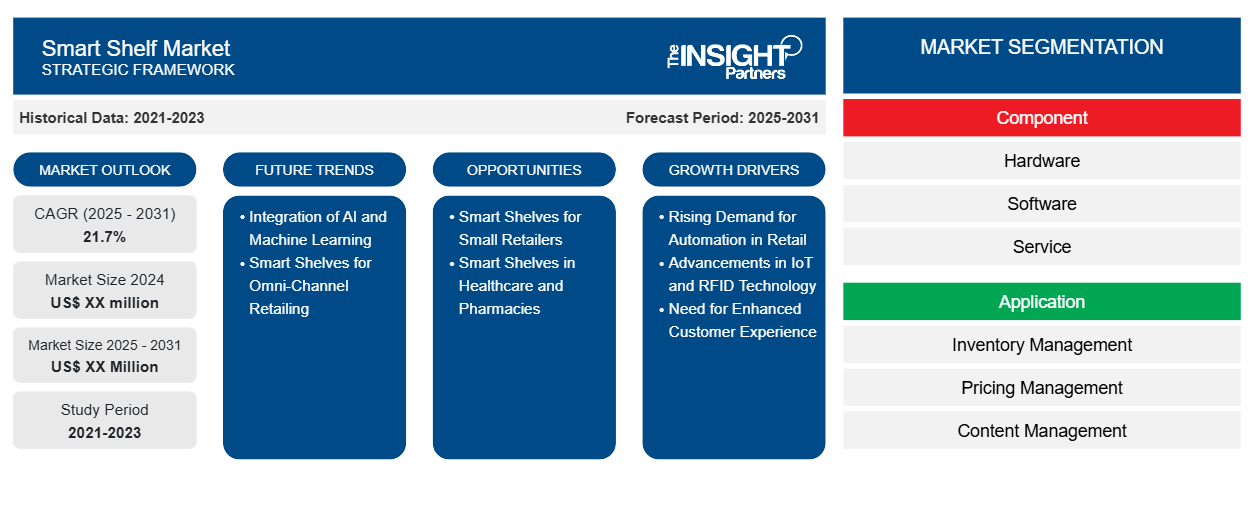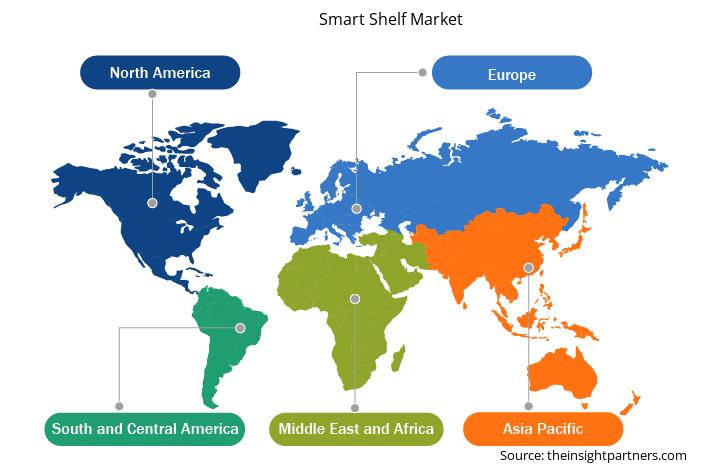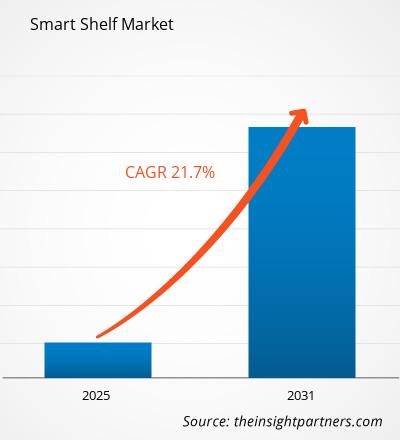Le marché des étagères intelligentes devrait enregistrer un TCAC de 21,7 % de 2025 à 2031, avec une taille de marché passant de XX millions de dollars américains en 2024 à XX millions de dollars américains d'ici 2031.
Le rapport est segmenté par composant (matériel (capteurs IoT, étiquettes et lecteurs RFID, étiquettes électroniques de gondole, caméras), logiciel, service) et application (gestion des stocks, gestion des prix, gestion de contenu, gestion des planogrammes). L'analyse globale est ensuite ventilée par région et par principaux pays. Le rapport présente la valeur en USD pour l'analyse et les segments ci-dessus.
Objet du rapport
Le rapport « Smart Shelf Market » de The Insight Partners vise à décrire le paysage actuel et la croissance future, les principaux moteurs, les défis et les opportunités. Il fournira des informations aux différents acteurs de l'entreprise, notamment :
- Fournisseurs/fabricants de technologies : pour comprendre l’évolution de la dynamique du marché et connaître les opportunités de croissance potentielles, leur permettant de prendre des décisions stratégiques éclairées.
- Investisseurs : réaliser une analyse complète des tendances concernant le taux de croissance du marché, les projections financières du marché et les opportunités qui existent tout au long de la chaîne de valeur.
- Organismes de réglementation : Réglementer les politiques et les activités de police sur le marché dans le but de minimiser les abus, de préserver la confiance des investisseurs et de maintenir l’intégrité et la stabilité du marché.
Segmentation du marché des étagères intelligentes
Composant
- Matériel
- Logiciel
- Service
Application
- Gestion des stocks
- Gestion des prix
- Gestion de contenu
- Gestion des planogrammes
Personnalisez ce rapport en fonction de vos besoins
Vous bénéficierez d'une personnalisation gratuite de n'importe quel rapport, y compris des parties de ce rapport, ou d'une analyse au niveau des pays, d'un pack de données Excel, ainsi que de superbes offres et réductions pour les start-ups et les universités.
Marché des étagères intelligentes : perspectives stratégiques

- Obtenez les principales tendances clés du marché de ce rapport.Cet échantillon GRATUIT comprendra une analyse de données, allant des tendances du marché aux estimations et prévisions.
Moteurs de croissance du marché des étagères intelligentes
- Demande croissante d'automatisation dans le commerce de détail : Alors que les détaillants cherchent à rationaliser leurs opérations et à améliorer leur efficacité, les technologies de rayonnages intelligents gagnent en importance. Ces solutions permettent d'automatiser le suivi des stocks, le placement des produits et la mise à jour des stocks en temps réel, réduisant ainsi le travail manuel et les erreurs humaines. Cette demande d'automatisation favorise l'adoption des rayonnages intelligents dans les environnements de vente au détail.
- Progrès de l'IoT et de la technologie RFID : Le développement de l'Internet des objets (IoT) et de la technologie d'identification par radiofréquence (RFID) est un moteur important du marché des étagères intelligentes. Ces technologies permettent un suivi des stocks en temps réel, une meilleure visibilité des produits et la surveillance de l'état des rayons, ce qui améliore la gestion des rayons, l'expérience client et réduit les coûts d'exploitation.IoT and RFID Technology: The growth of the Internet of Things (IoT) and Radio Frequency Identification (RFID) technology is a significant driver for the smart shelf market. These technologies enable real-time inventory tracking, enhanced product visibility, and the ability to monitor shelf conditions, leading to improved shelf management, better customer experiences, and reduced operational costs.
- Besoin d'une expérience client améliorée : Les détaillants accordent une importance croissante à l'amélioration de l'expérience client pour rester compétitifs. Les étagères intelligentes offrent des expériences d'achat dynamiques et personnalisées en proposant des informations produits en temps réel, des promotions et des mises à jour des stocks, ce qui permet d'attirer et de fidéliser les consommateurs plus efficacement.
Tendances futures du marché des étagères intelligentes
- Intégration de l'IA et de l'apprentissage automatique : L'avenir du marché des étagères intelligentes verra l'intégration d'algorithmes d'intelligence artificielle (IA) et d'apprentissage automatique (ML) pour améliorer la gestion des stocks. Ces technologies permettront l'analyse prédictive, permettant aux détaillants d'anticiper les niveaux de stock, les préférences des clients et les tendances en temps réel, optimisant ainsi la gestion des rayons et améliorant les prévisions de ventes.
- Rayonnages intelligents pour le commerce omnicanal : Avec l'évolution du commerce de détail vers des modèles omnicanaux, l'intégration des rayonnages intelligents aux plateformes en ligne deviendra de plus en plus importante. Ces rayonnages faciliteront l'intégration transparente entre les stocks en magasin et en ligne, garantissant des niveaux de stock précis, une meilleure coordination entre les magasins en ligne et physiques, et une satisfaction client accrue, tant en ligne qu'en magasin.
Opportunités du marché des étagères intelligentes
- Rayonnages intelligents pour les petits détaillants : Si les grands distributeurs ont déjà commencé à adopter les technologies de rayonnages intelligents, les petites et moyennes entreprises (PME) représentent un marché en pleine expansion et encore inexploité. Il existe une opportunité de créer des solutions de rayonnages intelligents économiques et évolutives, spécialement conçues pour les PME, leur permettant d'optimiser la gestion des stocks, d'améliorer l'expérience client et de concurrencer les grandes enseignes.
- Étagères intelligentes dans les secteurs de la santé et des pharmacies : Au-delà des environnements de vente traditionnels, de nouvelles opportunités se présentent pour la mise en œuvre de solutions d'étagères intelligentes dans les secteurs de la santé et des pharmacies. Ces étagères peuvent faciliter la gestion des produits pharmaceutiques, garantir leur bon stockage et faciliter le suivi des dates de péremption. Il s'agit d'une opportunité unique de pénétrer un nouveau secteur exigeant précision et efficacité.
Aperçu régional du marché des étagères intelligentes
Les tendances régionales et les facteurs influençant le marché des étagères intelligentes tout au long de la période de prévision ont été analysés en détail par les analystes d'Insight Partners. Cette section aborde également les segments et la géographie du marché des étagères intelligentes en Amérique du Nord, en Europe, en Asie-Pacifique, au Moyen-Orient et en Afrique, ainsi qu'en Amérique du Sud et en Amérique centrale.

- Obtenez les données régionales spécifiques au marché des étagères intelligentes
Portée du rapport sur le marché des étagères intelligentes
| Attribut de rapport | Détails |
|---|---|
| Taille du marché en 2024 | XX millions de dollars américains |
| Taille du marché d'ici 2031 | XX millions de dollars américains |
| TCAC mondial (2025 - 2031) | 21,7% |
| Données historiques | 2021-2023 |
| Période de prévision | 2025-2031 |
| Segments couverts | Par composant
|
| Régions et pays couverts | Amérique du Nord
|
| Leaders du marché et profils d'entreprises clés |
|
Densité des acteurs du marché des étagères intelligentes : comprendre son impact sur la dynamique des entreprises
Le marché des étagères intelligentes connaît une croissance rapide, portée par une demande croissante des utilisateurs finaux, due à des facteurs tels que l'évolution des préférences des consommateurs, les avancées technologiques et une meilleure connaissance des avantages du produit. Face à cette demande croissante, les entreprises élargissent leur offre, innovent pour répondre aux besoins des consommateurs et capitalisent sur les nouvelles tendances, ce qui alimente la croissance du marché.
La densité des acteurs du marché désigne la répartition des entreprises opérant sur un marché ou un secteur particulier. Elle indique le nombre de concurrents (acteurs) présents sur un marché donné par rapport à sa taille ou à sa valeur marchande totale.
Les principales entreprises opérant sur le marché des étagères intelligentes sont :
- SES-Imagotag
- Pricer
- Trax
- Avery Dennison
- Samsung
- Encre électronique
Avertissement : Les entreprises répertoriées ci-dessus ne sont pas classées dans un ordre particulier.

- Obtenez un aperçu des principaux acteurs du marché des étagères intelligentes
Principaux arguments de vente
- Couverture complète : Le rapport couvre de manière exhaustive l'analyse des produits, des services, des types et des utilisateurs finaux du marché des étagères intelligentes, offrant un paysage holistique.
- Analyse d’experts : Le rapport est compilé sur la base d’une compréhension approfondie des experts et analystes du secteur.
- Informations à jour : Le rapport garantit la pertinence commerciale en raison de sa couverture des informations récentes et des tendances des données.
- Options de personnalisation : ce rapport peut être personnalisé pour répondre aux exigences spécifiques des clients et s'adapter de manière appropriée aux stratégies commerciales.
Le rapport de recherche sur le marché des étagères intelligentes peut donc contribuer à décrypter et à comprendre le contexte et les perspectives de croissance du secteur. Malgré quelques inquiétudes légitimes, les avantages globaux de ce rapport l'emportent généralement sur ses inconvénients.
- Analyse historique (2 ans), année de base, prévision (7 ans) avec TCAC
- Analyse PEST et SWOT
- Taille du marché Valeur / Volume - Mondial, Régional, Pays
- Industrie et paysage concurrentiel
- Ensemble de données Excel
Rapports récents
Témoignages
Raison d'acheter
- Prise de décision éclairée
- Compréhension de la dynamique du marché
- Analyse concurrentielle
- Connaissances clients
- Prévisions de marché
- Atténuation des risques
- Planification stratégique
- Justification des investissements
- Identification des marchés émergents
- Amélioration des stratégies marketing
- Amélioration de l'efficacité opérationnelle
- Alignement sur les tendances réglementaires




















 Obtenez un échantillon gratuit pour - Marché des étagères intelligentes
Obtenez un échantillon gratuit pour - Marché des étagères intelligentes